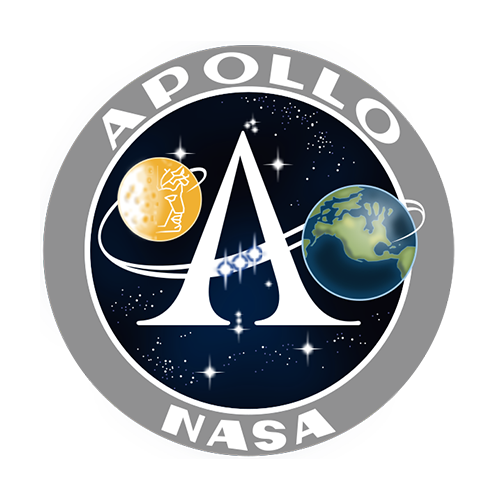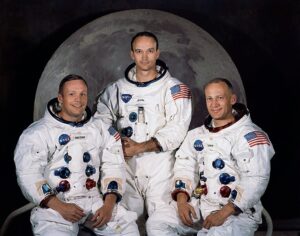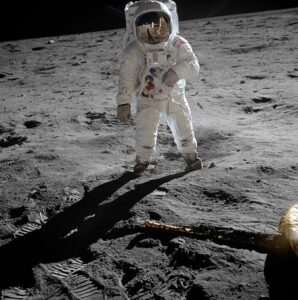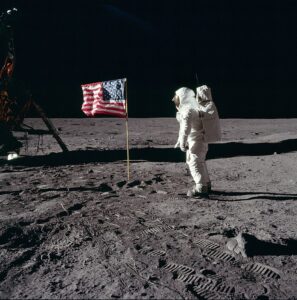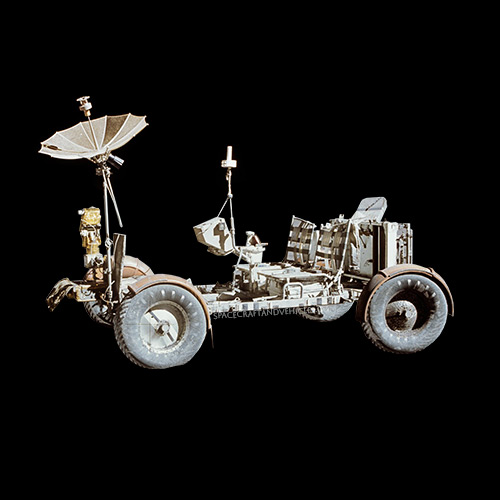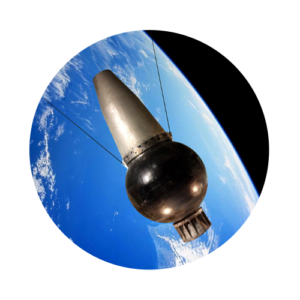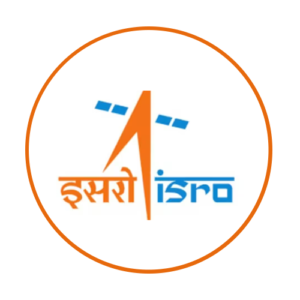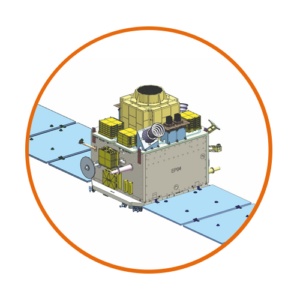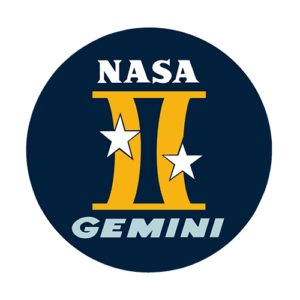The Apollo program, initiated by NASA in the early 1960s, stands as one of the most significant achievements in the history of space exploration. Its primary goal was to land humans on the Moon and return them safely to Earth.
Spanning from 1961 to 1972, the program encompassed a series of crewed missions, each building upon the successes and lessons learned from its predecessors. Led by visionaries and fueled by the determination to conquer new frontiers, the Apollo program propelled humanity into a new era of space exploration, leaving an indelible mark on scientific knowledge and inspiring generations to come.
Related content:
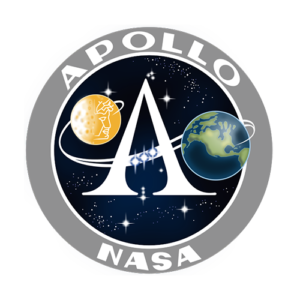
The Apollo Space Program
Explore the iconic Apollo spacecraft, which made history by landing humans on the Moon and returning them safely to Earth.
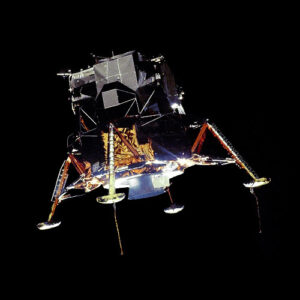
Apollo Lunar Module (LM)
Discover the engineering marvel that enabled humanity’s first steps on the Moon – the Apollo Lunar Module and learn about its design.
List of Apollo Missions in Order
The Apollo program represents a pinnacle of human achievement in space exploration, marking a period of unprecedented scientific discovery and technological advancement. Each mission contributed valuable knowledge and experience, paving the way for future exploration of the cosmos.
Tragically, a cabin fire during a pre-launch test killed all three astronauts, delaying the program.
Intended as the first crewed mission of the Apollo program, Apollo 1 ended in a cabin fire during a pre-launch test on the launch pad at Kennedy Space Center. The accident resulted in the loss of all three astronauts and prompted significant changes to spacecraft design and safety protocols.
- Date: January 27, 1967
- Crew: Virgil “Gus” Grissom 🔗, Edward H. White II 🔗, Roger B. Chaffee 🔗
Apollo 2 to 6 (Uncrewed Tests)
While there were no Apollo missions designated as Apollo 2 to Apollo 6, several uncrewed test flights were conducted to validate the Apollo spacecraft and Saturn launch vehicle systems.
These missions included:
- Apollo 2 (AS-203): Uncrewed suborbital test of the Saturn IB launch vehicle.
- Apollo 3 (AS-202): Uncrewed test flight of the Saturn IB with the boilerplate Apollo Command and Service Module (CSM).
- Apollo 4 (AS-501): First uncrewed test flight of the Saturn V launch vehicle. The mission orbited the Earth to test the Saturn V’s performance.
- Apollo 5 (AS-204): Uncrewed test of the Lunar Module (LM) in Earth orbit to demonstrate its ascent and descent engines.
- Apollo 6 (AS-502): Second uncrewed test flight of the Saturn V launch vehicle. The mission experienced significant issues, including engine failures and oscillations, but still provided valuable data for future missions.
Apollo 7
The first successful crewed Apollo mission tested the Command and Service Module in Earth orbit.
Apollo 7 marked the first crewed flight of the Apollo program. It was an Earth orbital mission aimed at testing the Apollo Command and Service Module (CSM) in space for the first time. The crew performed a series of tests and maneuvers, including rendezvous and docking with the spent Saturn IB stage. The mission was critical in demonstrating the spacecraft’s performance and systems for future crewed lunar missions.
- Date: October 11-22, 1968
- Crew: Walter M. Schirra 🔗, Jr., Donn F. Eisele 🔗, Walter Cunningham 🔗
Apollo 8
First human mission to orbit the Moon, providing the iconic “Earthrise” photo.
Apollo 8 was the first crewed mission to orbit the Moon. Although it did not land on the lunar surface, it provided humanity’s first close-up views of the Moon’s surface and captured the iconic “Earthrise” photograph. The crew conducted lunar orbit insertion, ten orbits around the Moon, and a successful return to Earth. Apollo 8 demonstrated the feasibility of crewed lunar missions and paved the way for Apollo 11’s historic landing.
- Date: December 21-27, 1968
- Crew: Frank Borman 🔗, James Lovell 🔗, William Anders 🔗
Apollo 9
Tested the Lunar Module in Earth orbit for the first time, vital for future Moon landings.
Apollo 9 was an Earth orbital mission that tested the Apollo Lunar Module (LM) in space for the first time. The crew performed the first crewed test of the complete Apollo spacecraft, including docking and undocking maneuvers between the Command Module (CM) and the Lunar Module (LM). They also conducted extravehicular activities (EVAs) to evaluate the LM’s performance in space.
- Date: March 3-13, 1969
- Crew: James McDivitt 🔗, David Scott 🔗, Russell Schweickart 🔗
Apollo 10
“Dress rehearsal” for the Moon landing, with the Lunar Module flying to within 9 miles of the lunar surface.
Apollo 10 was a “dress rehearsal” for the first crewed lunar landing. The mission orbited the Moon and tested all aspects of the lunar landing mission, including the lunar module’s descent to within 15 kilometers of the lunar surface. While the LM descended close to the surface, the crew did not attempt a landing. Apollo 10 provided valuable data and experience that contributed to the success of Apollo 11.
- Date: May 18-26, 1969
- Crew: Thomas Stafford, John Young, Eugene Cernan
Apollo 11
Neil Armstrong and Buzz Aldrin became the first humans to land on the Moon, marking a monumental achievement in space exploration.
Apollo 11 was the first crewed mission to land on the Moon. Neil Armstrong and Buzz Aldrin became the first humans to set foot on the lunar surface, while Michael Collins remained in lunar orbit aboard the Command Module. The mission achieved President John F. Kennedy’s goal of landing a man on the Moon and returning him safely to Earth, marking a historic milestone in human space exploration.
- Date: July 16-24, 1969
- Crew: Neil Armstrong 🔗, Buzz Aldrin 🔗, Michael Collins 🔗
Apollo 12
Successfully landed near the Surveyor 3 probe, demonstrating pinpoint landing capability on the Moon.
Apollo 12 was the second crewed lunar landing mission. The crew successfully landed near the Surveyor 3 spacecraft, conducted two moonwalks, and collected lunar samples. Shortly after liftoff, the mission encountered lightning strikes, but the spacecraft systems were quickly restored, leading to a successful mission.
- Date: November 14-24, 1969
- Crew: Charles Conrad Jr. 🔗, Alan L. Bean 🔗, Richard F. Gordon Jr. 🔗
Apollo 13
A critical in-flight oxygen tank explosion forced a dramatic and successful effort to return the crew safely to Earth.
Apollo 13 was intended as the third crewed lunar landing mission but was aborted following an oxygen tank explosion that crippled the spacecraft. The crew, using the lunar module as a lifeboat, navigated a perilous journey back to Earth, ultimately achieving a safe splashdown. Despite the mission’s failure to land on the Moon, it demonstrated NASA’s ability to handle crisis situations and resulted in valuable lessons for future missions.
- Date: April 11-17, 1970
- Crew: James Lovell 🔗, John Swigert 🔗, Fred Haise 🔗
Apollo 14
First scientific-focused mission to the Moon, featuring the famous golf shot by Alan Shepard.
Apollo 14 was the third crewed lunar landing mission. The crew successfully landed in the Fra Mauro region of the Moon, conducted two moonwalks, and collected extensive geological samples. Commander Alan Shepard famously hit golf balls on the lunar surface, demonstrating the reduced gravity environment.
- Date: January 31-February 9, 1971
- Crew: Alan Shepard 🔗, Stuart Roosa 🔗, Edgar Mitchell 🔗
Apollo 15
First mission to carry the Lunar Rover, allowing astronauts to explore more of the Moon’s surface.
Apollo 15 was the fourth crewed lunar landing mission and the first to use the Lunar Roving Vehicle (LRV) to explore the lunar surface. The crew conducted three moonwalks, collected a significant amount of lunar samples, and deployed scientific instruments. The mission also marked the first use of a Lunar Module liftoff stage to return to lunar orbit.
- Date: July 26-August 7, 1971
- Crew: David Scott 🔗, James Irwin 🔗, Alfred Worden 🔗
Apollo 16
Explored the lunar highlands, conducting detailed geological studies.
Apollo 16 was the fifth crewed lunar landing mission. The crew explored the Descartes Highlands region of the Moon, conducted three moonwalks, and collected geological samples. They deployed scientific instruments, including a heat flow experiment and a lunar surface magnetometer.
- Date: April 16-27, 1972
- Crew: John Young 🔗, Charles Duke 🔗, Thomas Mattingly 🔗
Apollo 17
The last Apollo Moon mission, highlighted by the longest lunar surface stay and significant scientific discoveries.
Apollo 17 was the sixth and final crewed lunar landing mission. It included geologist-astronaut Harrison Schmitt and focused on extensive scientific exploration of the Taurus-Littrow region of the Moon. The crew conducted three moonwalks, collected a record amount of lunar samples, and deployed scientific instruments. Eugene Cernan, the mission commander, was the last human to walk on the lunar surface to date.
- Date: December 7-19, 1972
- Crew: Eugene Cernan 🔗, Harrison Schmitt 🔗, Ronald Evans 🔗
